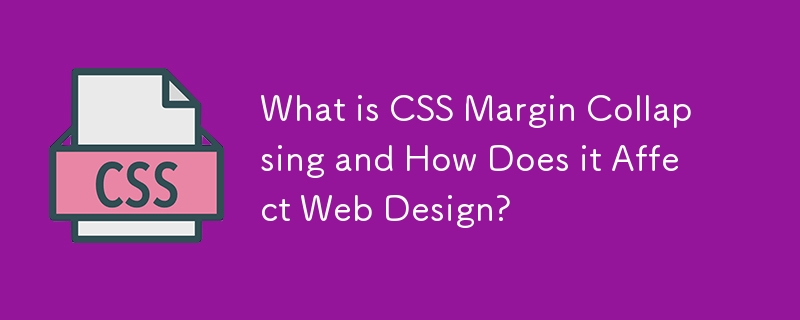What is CSS Margin Collapsing and How Does it Affect Web Design?

Understanding CSS Collapsing Margins
CSS collapsing margins is a feature that affects the vertical margins of adjacent elements within a block-level container. When margins collapse, they effectively merge into a single margin, resulting in reduced spacing between the elements.
Purpose of Margin Collapse
Margin collapse may seem like a design nuisance at times, but it actually serves an important function:
- Ensures Consistent Spacing: Margins define the amount of space between an element and its surroundings. If margins weren't allowed to collapse, the spacing between elements would become unpredictable and potentially inconsistent. By collapsing adjacent vertical margins, CSS ensures that elements are evenly spaced without creating excessive gaps.
- Prevents Overlapping: Imagine a scenario where multiple elements with top and bottom margins are stacked vertically. If margins didn't collapse, these margins would overlap, resulting in elements colliding with each other. Collapsing margins prevents this overlap, ensuring that elements remain separate.
- Defines Clear Boundaries: Margins help define the boundaries of elements within a container. When margins collapse, they create a clear visual separation between elements, making it easier to distinguish between different sections of content.
Understanding the Collapsing Rule
The rule for margin collapsing is relatively straightforward:
- Only vertical margins collapse: Horizontal margins (left and right) never collapse.
- Only adjacent margins collapse: Margins between non-adjacent elements do not collapse.
- Collapsing stops at transparent elements: If an element has no background or visible border, its margins will not participate in margin collapse.
Implications for Design
Understanding the purpose of margin collapse is crucial for effective web design. Here are some implications to consider:
- Use margins sparingly: Uncontrolled margins can quickly lead to excessive spacing and design issues.
- Consider negative margins: Negative margins can be used to overlap elements or create a more visually compact design.
- Use padding for internal spacing: If you need to adjust the spacing within an element, use CSS padding instead of margins, as padding does not collapse.
The above is the detailed content of What is CSS Margin Collapsing and How Does it Affect Web Design?. For more information, please follow other related articles on the PHP Chinese website!

Hot AI Tools

Undresser.AI Undress
AI-powered app for creating realistic nude photos

AI Clothes Remover
Online AI tool for removing clothes from photos.

Undress AI Tool
Undress images for free

Clothoff.io
AI clothes remover

Video Face Swap
Swap faces in any video effortlessly with our completely free AI face swap tool!

Hot Article

Hot Tools

Notepad++7.3.1
Easy-to-use and free code editor

SublimeText3 Chinese version
Chinese version, very easy to use

Zend Studio 13.0.1
Powerful PHP integrated development environment

Dreamweaver CS6
Visual web development tools

SublimeText3 Mac version
God-level code editing software (SublimeText3)

Hot Topics
 1667
1667
 14
14
 1426
1426
 52
52
 1328
1328
 25
25
 1273
1273
 29
29
 1255
1255
 24
24
 A Comparison of Static Form Providers
Apr 16, 2025 am 11:20 AM
A Comparison of Static Form Providers
Apr 16, 2025 am 11:20 AM
Let’s attempt to coin a term here: "Static Form Provider." You bring your HTML
 A Proof of Concept for Making Sass Faster
Apr 16, 2025 am 10:38 AM
A Proof of Concept for Making Sass Faster
Apr 16, 2025 am 10:38 AM
At the start of a new project, Sass compilation happens in the blink of an eye. This feels great, especially when it’s paired with Browsersync, which reloads
 Weekly Platform News: HTML Loading Attribute, the Main ARIA Specifications, and Moving from iFrame to Shadow DOM
Apr 17, 2025 am 10:55 AM
Weekly Platform News: HTML Loading Attribute, the Main ARIA Specifications, and Moving from iFrame to Shadow DOM
Apr 17, 2025 am 10:55 AM
In this week's roundup of platform news, Chrome introduces a new attribute for loading, accessibility specifications for web developers, and the BBC moves
 Some Hands-On with the HTML Dialog Element
Apr 16, 2025 am 11:33 AM
Some Hands-On with the HTML Dialog Element
Apr 16, 2025 am 11:33 AM
This is me looking at the HTML element for the first time. I've been aware of it for a while, but haven't taken it for a spin yet. It has some pretty cool and
 Paperform
Apr 16, 2025 am 11:24 AM
Paperform
Apr 16, 2025 am 11:24 AM
Buy or build is a classic debate in technology. Building things yourself might feel less expensive because there is no line item on your credit card bill, but
 Where should 'Subscribe to Podcast' link to?
Apr 16, 2025 pm 12:04 PM
Where should 'Subscribe to Podcast' link to?
Apr 16, 2025 pm 12:04 PM
For a while, iTunes was the big dog in podcasting, so if you linked "Subscribe to Podcast" to like:
 It's All In the Head: Managing the Document Head of a React Powered Site With React Helmet
Apr 15, 2025 am 11:01 AM
It's All In the Head: Managing the Document Head of a React Powered Site With React Helmet
Apr 15, 2025 am 11:01 AM
The document head might not be the most glamorous part of a website, but what goes into it is arguably just as important to the success of your website as its
 Options for Hosting Your Own Non-JavaScript-Based Analytics
Apr 15, 2025 am 11:09 AM
Options for Hosting Your Own Non-JavaScript-Based Analytics
Apr 15, 2025 am 11:09 AM
There are loads of analytics platforms to help you track visitor and usage data on your sites. Perhaps most notably Google Analytics, which is widely used




